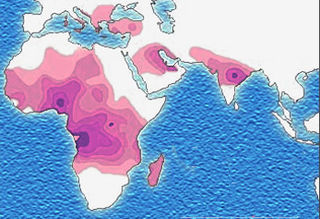Genetics
Sickle Cell Anemia Isn’t Evidence for the Existence of Races
The fact that blacks get sickle cell anemia doesn’t mean that races exist.
Posted March 19, 2013 Reviewed by Davia Sills

Many of my columns are an attempt to disentangle the confusions of biology and culture that lead to misunderstandings about race, and my recent book, The Myth of Race, attempts to shed light on the subject. The confusion I want to clear up here concerns sickle cell anemia.
Many people argue as follows, “How can you say that the human species has no biological races when blacks get sickle cell anemia, and whites don’t?” (Actually, a few whites in the United States do get sickle cell anemia, but a much smaller percentage do than among blacks.) The mistaken reasoning goes as follows: Skin color is inherited, and sickle cell disease is inherited; therefore, sickle cell disease is caused by race. Therefore, races exist.
I have written extensively about the difference between the concepts of social race and biological race. Many cultures use the word race to categorize people based on what they look like or how their ancestors were categorized, and these systems of social classification vary widely from one culture to another. (Anthropologists call them folk taxonomies.)
Biologically, though, humans—in contrast to some large, territorial land mammals, like wolves—have too little genetic variability to have biological races. This is in part because humans migrate more freely than other mammals: They don’t have the same limits on their ability to feed themselves and survive in different climates.
Sickle cell anemia is a blood disease. Usually, red blood cells are round, filled with oxygen, and flow easily through blood vessels. Sickle-shaped (or crescent-shaped, or banana-shaped) cells carry less oxygen and can pile up in small blood vessels and block the flow of blood, thereby depriving cells of oxygen.
Understanding sickle cell disease is actually quite interesting and leads to unexpected insights.
Chromosomes come in pairs, so an individual can have zero, one, or two genes for sickle cell disease. With two genes, an individual has the disease. With one gene, he or she is a carrier (and has a 50-50 chance of passing the gene on to the next generation) but does not have the disease. (The person will have some sickle cells but will receive an adequate supply of oxygen.)
Since sickle cell disease is very serious, one might ask why so many people have it. Why didn’t carriers of the gene die off long ago? It turns out that people who have only one gene are protected against malaria. That is, in malaria-infested areas, they will either not get the disease or will have it in a milder form.

In other words, in historically malaria-infested areas, people without the gene were likely to die of malaria, while those with two copies of the gene were likely to die of sickle cell disease. Over time, an equilibrium was reached, so that an optimal percentage of the population carried the gene—any more or less and a greater percentage of people would die from one or the other disease
West Africa, the main historical source of American slaves, had a lot of malaria, and the sickle cell gene was and still is widespread there. However, the gene can also be found in other areas of the world, including Southern Europe (Corsica, Greece, Portugal, Sardinia, Southern Italy, Sicily, and Spain). In addition, the gene is absent in much of southern and eastern Africa
In other words, the gene is not associated with a biological race, but rather with a biological disease, malaria. It was a historical accident that caused a correlation of the disease with a social race in the United States.
Here is a thought experiment to make this point explicit. Suppose that instead of Northern Europeans, Southern Europeans had settled the United States. And suppose that slaves had been brought from malaria-free areas of Africa. With such a history, sickle cell anemia would have been a white disease (and people might have argued, equally fallaciously, that it was evidence for the existence of biological races).
Other hypothetical histories might have brought both whites and blacks from malaria-free areas (neither group would have the disease), or might have brought both from malaria-infested areas (both groups would have had it). In these latter cases, case sickle cell disease would not have been used as an argument for the existence of races
This is why the fact that blacks get sickle cell anemia isn’t evidence for the existence of races.
References
Image Sources:
1. Wikimedia Commons: Sickle cells characterize sickle cell anemia, an autosomal recessive genetic disorder.
United States, National Human Genome Research Institute, website at genome.gov
http://commons.wikimedia.org/wiki/File:Sicklecells4.jpg
2. Sickle cell distribution
Wikimedia Commons (based on http://www.understandingrace.org/humvar/sickle_01.html)
http://commons.wikimedia.org/wiki/File:Sickle_cell_distribution.jpg




